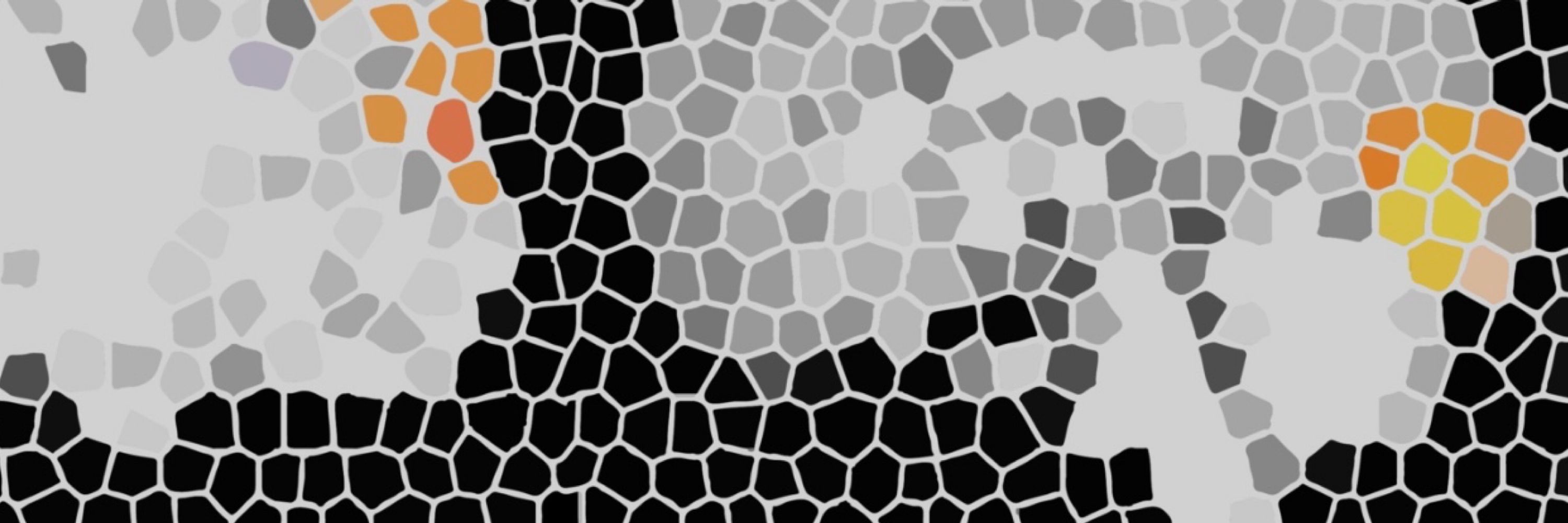
Rosanne Rademaker
@rademaker.bsky.social
Max Planck group leader at ESI Frankfurt | human cognition, fMRI, MEG, computation | sciences with the coolest (phd) students et al. | she/her
Bonus re-analysis of a whole bunch of EEG data: Spatial position decoding is SO MUCH better along the horizontal compared to the vertical meridian! N/N
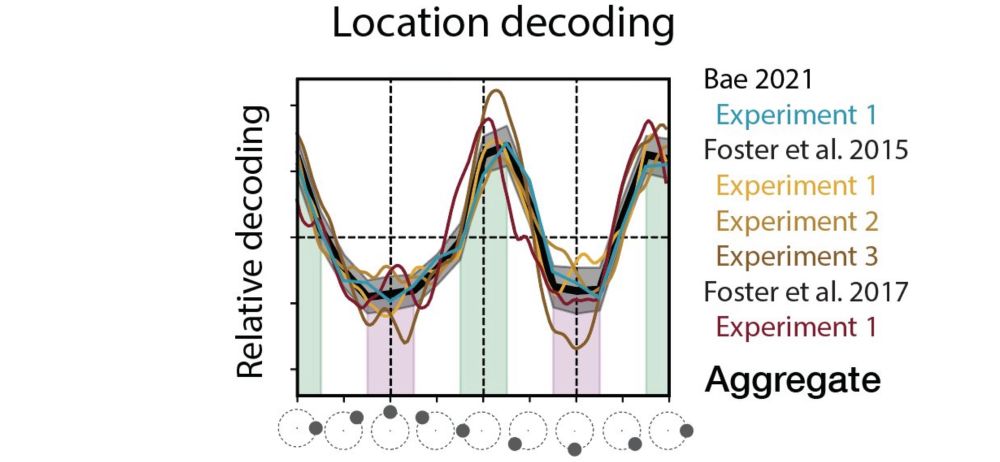
July 2, 2025 at 9:12 AM
Bonus re-analysis of a whole bunch of EEG data: Spatial position decoding is SO MUCH better along the horizontal compared to the vertical meridian! N/N
We replicated the horizontal-vertical decoding differences for centrally presented gratings using independent data. But look! This decoding difference is entirely absent for laterally presented gratings! 12/N

July 2, 2025 at 8:56 AM
We replicated the horizontal-vertical decoding differences for centrally presented gratings using independent data. But look! This decoding difference is entirely absent for laterally presented gratings! 12/N
And remember vignetting? Higher orientation energy at grating-edges aligned with an orientation contributes to decoding (Roth et al., 2018). Visual field anisotropies and vignetting can interact. 10/N
elifesciences.org/articles/37241
elifesciences.org/articles/37241
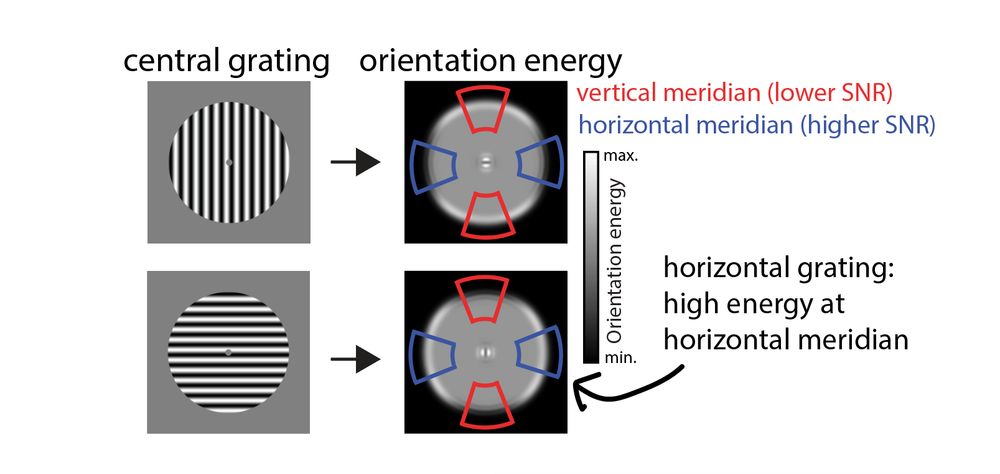
July 2, 2025 at 8:56 AM
And remember vignetting? Higher orientation energy at grating-edges aligned with an orientation contributes to decoding (Roth et al., 2018). Visual field anisotropies and vignetting can interact. 10/N
elifesciences.org/articles/37241
elifesciences.org/articles/37241
But there’s an inverse problem here: The underlying neural tuning cannot be inferred due to model mimicry: Many possible “sensory coding schemes” can generate very similar outcomes. Look what happens when we consider a slightly larger parameter space… 7/N

July 2, 2025 at 8:56 AM
But there’s an inverse problem here: The underlying neural tuning cannot be inferred due to model mimicry: Many possible “sensory coding schemes” can generate very similar outcomes. Look what happens when we consider a slightly larger parameter space… 7/N
This sensory coding scheme embeds a prior (from natural image statistics) via redistribution of orientation tuning functions, with more functions around horizontal vs. vertical – not predicted by previous proposals! But… How to recover sensory tuning from EEG data? 5/N
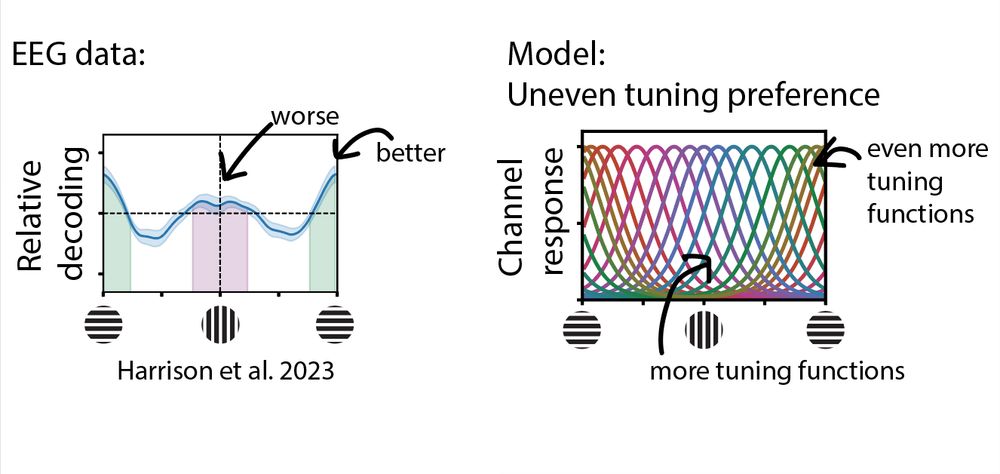
July 2, 2025 at 8:56 AM
This sensory coding scheme embeds a prior (from natural image statistics) via redistribution of orientation tuning functions, with more functions around horizontal vs. vertical – not predicted by previous proposals! But… How to recover sensory tuning from EEG data? 5/N
Welcome #VSS2025! For those attending the sunny, beaches, and science at this years Florida conference, make sure not to miss the awesome talks and posters from our lab!
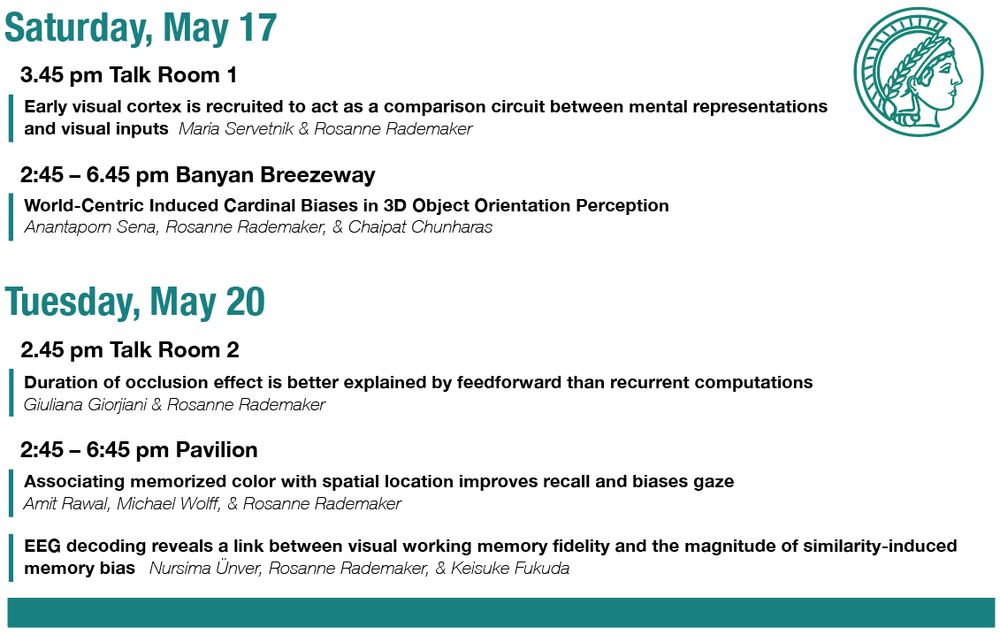
May 16, 2025 at 8:15 AM
Welcome #VSS2025! For those attending the sunny, beaches, and science at this years Florida conference, make sure not to miss the awesome talks and posters from our lab!
So... does visual cortex represent orientations veridically or categorically? During perception, the veridical model does a generally better job. During short-term memory, representational geometry becomes increasingly more categorical along the visual hierarchy!

March 17, 2025 at 8:33 AM
So... does visual cortex represent orientations veridically or categorically? During perception, the veridical model does a generally better job. During short-term memory, representational geometry becomes increasingly more categorical along the visual hierarchy!
We model what similarity of fMRI responses might look like when assuming that (1) the brain uses a veridical way to represent orientations, or (2) the brain categorizes orientations based on how different they appear in a more experiential sense.
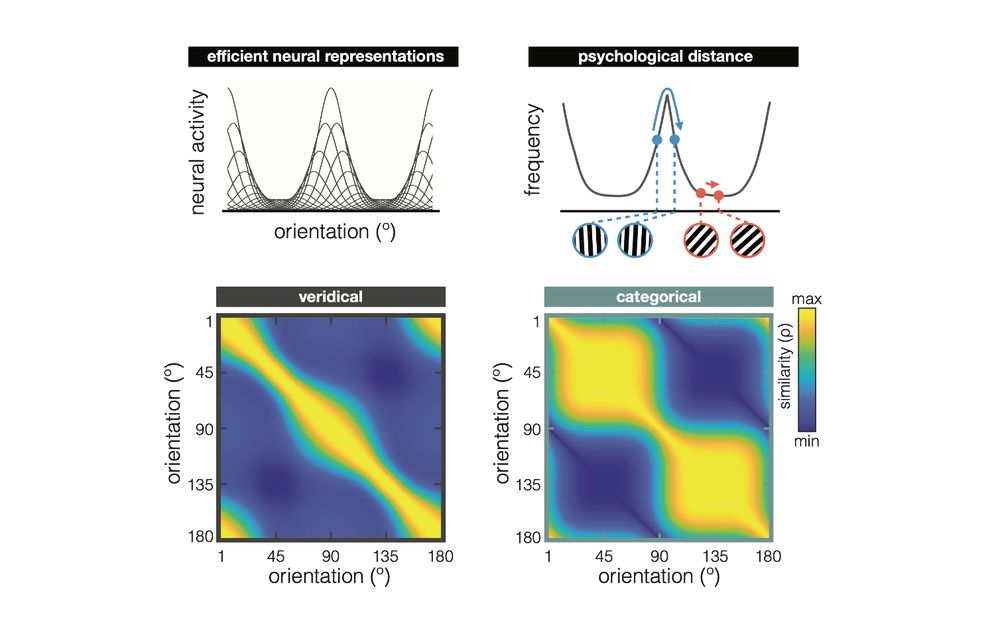
March 17, 2025 at 8:31 AM
We model what similarity of fMRI responses might look like when assuming that (1) the brain uses a veridical way to represent orientations, or (2) the brain categorizes orientations based on how different they appear in a more experiential sense.
Girshick, Landy, & Simoncelli (2011) showed it best: The natural world has more horizontal and vertical ("cardinal") orientations in it than those in between ("obliques"). We start from this uneven probability distribution over orientation.
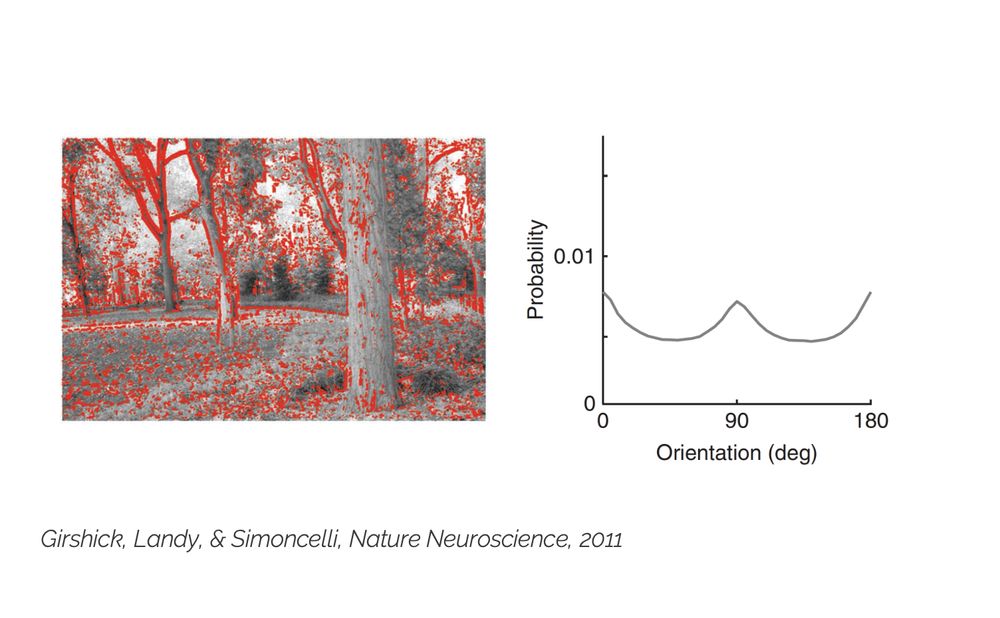
March 17, 2025 at 8:30 AM
Girshick, Landy, & Simoncelli (2011) showed it best: The natural world has more horizontal and vertical ("cardinal") orientations in it than those in between ("obliques"). We start from this uneven probability distribution over orientation.
To answer how perception and memory differ in visual cortex, we use line-images ("gratings") with different orientations that people look at, or remember, while we record voxel responses. We correlate patterns of responses evoked by all possible orientations & VOILA, "representational geometry"
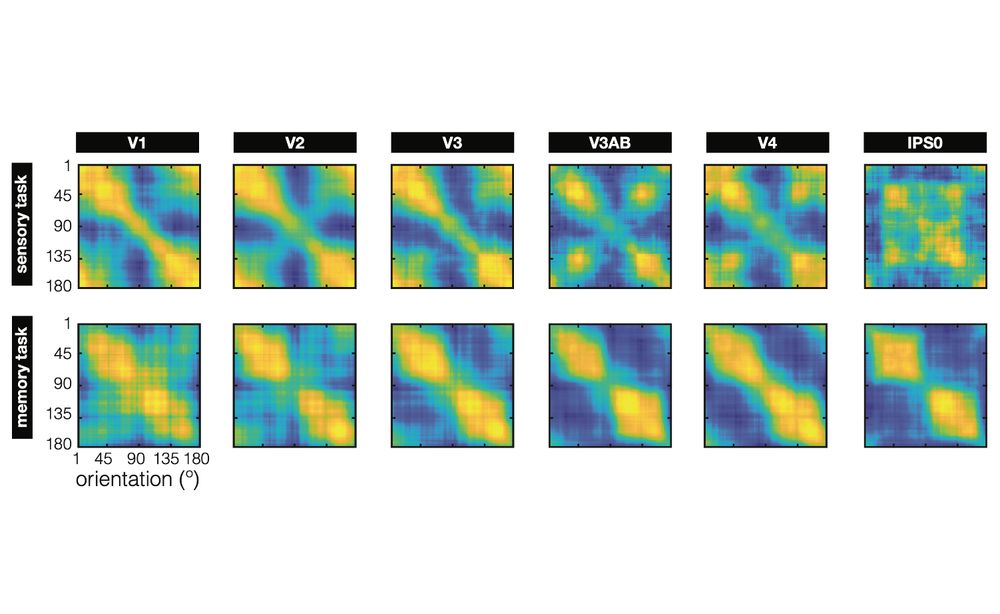
March 17, 2025 at 8:25 AM
To answer how perception and memory differ in visual cortex, we use line-images ("gratings") with different orientations that people look at, or remember, while we record voxel responses. We correlate patterns of responses evoked by all possible orientations & VOILA, "representational geometry"
Early visual cortex processes what we see around us, but also has information about images briefly held in mind. The two must be different... But different how?

March 17, 2025 at 8:23 AM
Early visual cortex processes what we see around us, but also has information about images briefly held in mind. The two must be different... But different how?
And what about the distractor itself, which is directly perceived throughout the delay? We show that attention actually enhances these sensory representations, especially when distractor orientation is attended. 7/n
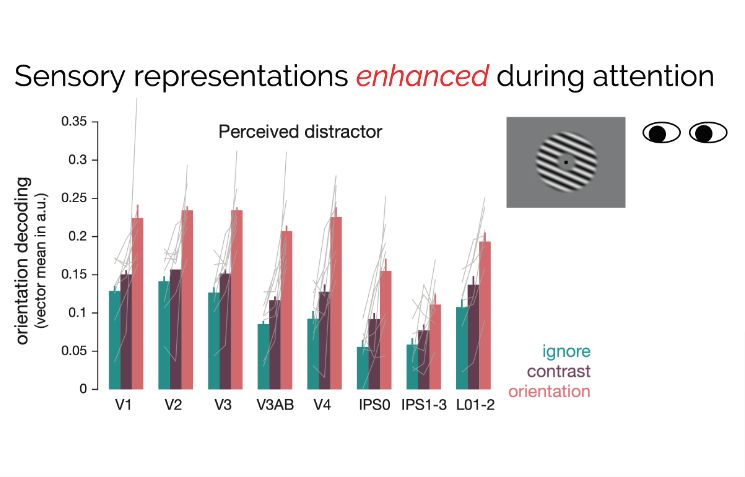
September 17, 2024 at 9:05 AM
And what about the distractor itself, which is directly perceived throughout the delay? We show that attention actually enhances these sensory representations, especially when distractor orientation is attended. 7/n
So, does attention negatively impact decoding of the orientation held in memory? Yes it does! Throughout the visual hierarchy we see a hit to decoding of the remembered target when attention is paid to the distractor 6/n

September 17, 2024 at 9:05 AM
So, does attention negatively impact decoding of the orientation held in memory? Yes it does! Throughout the visual hierarchy we see a hit to decoding of the remembered target when attention is paid to the distractor 6/n
Recall of the remembered orientation was worse when attention was diverted towards changes in distractor contrast and orientation. Univariate BOLD was also higher with attention, compared to when the distractor was ignored. 5/n
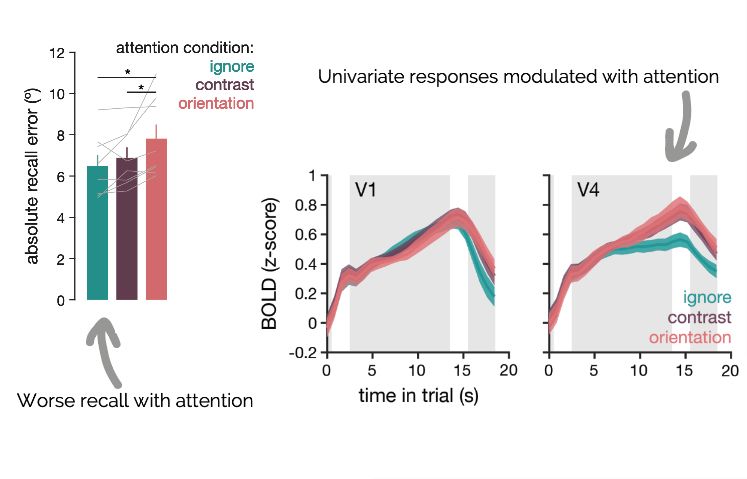
September 17, 2024 at 9:04 AM
Recall of the remembered orientation was worse when attention was diverted towards changes in distractor contrast and orientation. Univariate BOLD was also higher with attention, compared to when the distractor was ignored. 5/n
We scanned people over the course of several days. While they remembered an orientation, we showed another stimulus on the screen. This distractor had several small changes in its contrast or orientation on every trial. We manipulated just one thing: Attention. 4/n
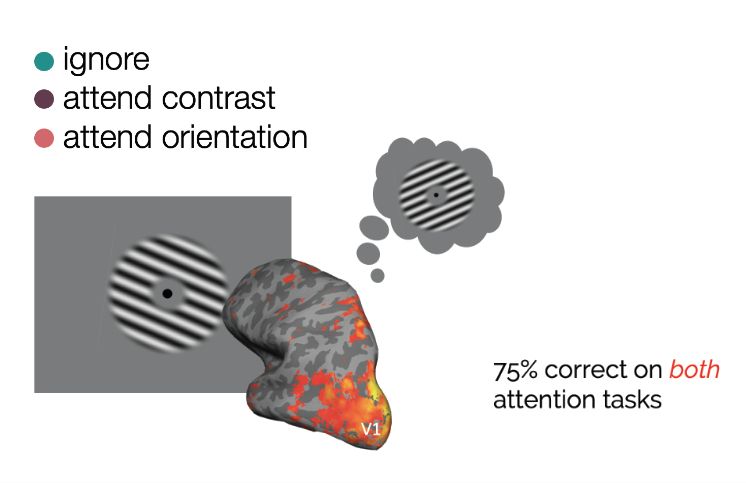
September 17, 2024 at 9:04 AM
We scanned people over the course of several days. While they remembered an orientation, we showed another stimulus on the screen. This distractor had several small changes in its contrast or orientation on every trial. We manipulated just one thing: Attention. 4/n
But everyday life also requires attention to the environment, so you can navigate it safely. When you hold an image in mind, this often happens concurrently with attention to visual inputs! Can visual cortex concurrently process competing top-down demands? 3/n

September 17, 2024 at 9:04 AM
But everyday life also requires attention to the environment, so you can navigate it safely. When you hold an image in mind, this often happens concurrently with attention to visual inputs! Can visual cortex concurrently process competing top-down demands? 3/n
Everyday life typically requires visual memory when there are concurrent visual inputs. Together with John Serences, we found out a while back that we can use fMRI to decode the contents of visual working memory from early sensory cortex, even during such concurrent visual input. 2/n
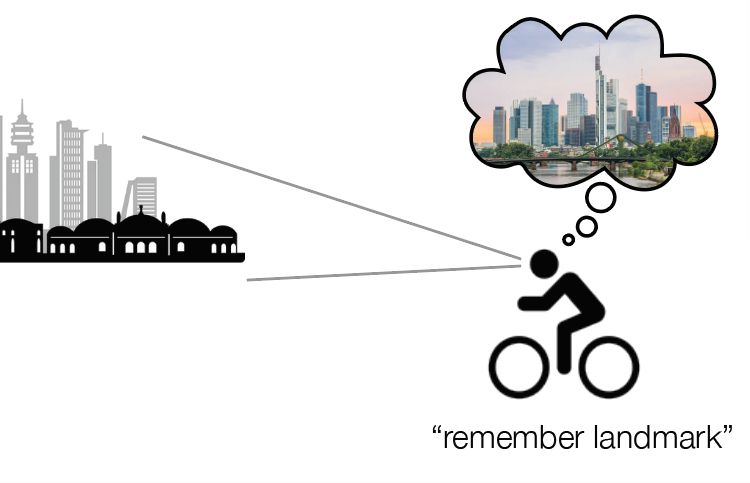
September 17, 2024 at 9:03 AM
Everyday life typically requires visual memory when there are concurrent visual inputs. Together with John Serences, we found out a while back that we can use fMRI to decode the contents of visual working memory from early sensory cortex, even during such concurrent visual input. 2/n

